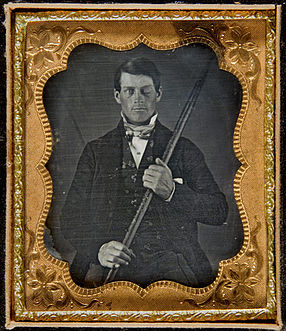Phineas Gage ~ “The American Crowbar Case”
Nobody would have ever heard of Phineas Gage today if he hadn’t been the victim of a freakish and bizarre accident. In 1848, when he was 25 years old and working as a railroad construction foreman, an accident with explosives caused an iron rod to be driven through the left side of his face, behind the eye and out the top of his head. Much of his brain’s left frontal lobe was destroyed. He was conscious after the accident and was able to talk and move, but for days afterward he was gravely ill and expected to die. Although he was to improve over time, he was known to exhibit marked personality and behavioral changes, about which little is known, or the facts that are (believed to be) known are contradictory.
The case of Phineas Gage was referred to in the nineteenth century as “the American Crowbar Case.” It influenced discussion about the mind and the brain, particularly debate on central localization, and was possibly the first case to suggest that damage to specific parts of the brain affect personality. Phineas Gage would surely have been surprised to find himself a fixture in the study of neurology, psychology, and related disciplines, and mentioned frequently in books and academic papers.
Phineas Gage was able to carry on with his life for a number of years after his accident, minus his left eye, but finally he succumbed to the damage done to his brain in 1860 at the age of 37. He is buried in the Lone Mountain Cemetery in San Francisco. His skull was exhumed and studied after his death and is housed at the Warren Anatomical Museum in Boston.
Copyright © 2013 by Allen Kopp

